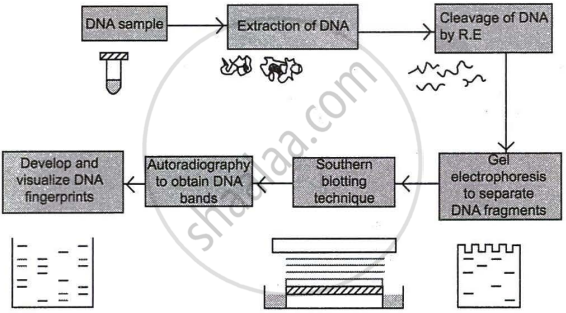Advertisements
Advertisements
प्रश्न
Name and describe the steps involved in the technique widely used in forensics that serves as the basis of paternity testing in case of disputes.
उत्तर
DNA fingerprinting is a technology used to do a paternity test to determine the true parents of a newborn infant. This approach is also known as "DNA profiling" since the DNA sequences of both parents and child are matched. To perform the paternity test, the following steps are involved:
- DNA sample: A DNA sample to be analysed is first collected.
- Extraction of DNA: DNA is then extracted from the sample by lysis method.
- Digestion by restriction endonucleases: Using a specific restriction enzyme, a DNA fragment is cut at a specific site. This is done to obtain RFLP (Restricted Fragment Length Polymorphism).
- Electrophoresis: Using gel electrophoresis, DNA fragments of various sizes are obtained.
- Denaturing DNA fragments: The gel containing DNA fragments is then immersed in NaOH solution. This will denature DNA into single-stranded DNA.
- Southern blotting technique: This is performed to transfer single-stranded DNA from the gel onto the nitrocellulose membrane.
- Hybridization: This DNA fragment is subjected to hybridization with a suitable DNA probe tagged with a radioactive substance.
- Comparing the sample: Using X-ray films, the DNA samples showing radioactivity are compared. This is the most reliable technique to find the parents of the newborn baby.

संबंधित प्रश्न
A number of passengers were severely burnt beyond recognition during a train accident. Name and describe a modern technique that can help hand over the dead to their relatives.
In gene cloning the DNA of interest is integrated in a ______.
Assertion: rDNA is superior over hybridisation techniques.
Reason: Desired genes are inserted without introducing the undesriable genes in target organisms.
Which of the following are the applications of DNA fingerprinting?
Identify the CORRECT sequence of steps involved DNA fingerprinting.
i. Isolation of genomic DNA
ii. Separation by electrophoresis
iii. Denaturation of DNA
iv. Hybridization with probe
v. Fragmenting DNA with restriction enzymes
vi. Southern Blotting
vii. Exposure on film
____________ are the DNA sequences which are useful in DNA fingerprinting.
For which of the following reason/s VNTRs is/are the key factor in DNA profiling?
Match the Column - I with Column - II and select the correct option
| Column - I | Column - II | ||
| (a) | Female banded Krait | (i) | Humulin |
| (b) | Pancreas from dog | (ii) | DNA sample |
| (c) | Hair root of human | (iii) | Insulin extracted and purified |
| (d) | E.coli | (iv) | DNA probe |
Short stretches of DNA used to identify the complementary sequences in a sample are called ______
Arrange the following steps of DNA fingerprinting in correct sequence:
- Gel electrophoresis
- Isolation of DNA
- Southern blotting
- Restriction digestion
